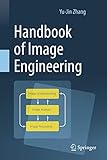Handbook of Image Engineering [electronic resource] /
Material type: TextPublisher: Singapore : Springer Nature Singapore : Imprint: Springer, 2021Edition: 1st ed. 2021Description: XXXII, 1967 p. 790 illus., 618 illus. in color. online resourceContent type:
TextPublisher: Singapore : Springer Nature Singapore : Imprint: Springer, 2021Edition: 1st ed. 2021Description: XXXII, 1967 p. 790 illus., 618 illus. in color. online resourceContent type: - text
- computer
- online resource
- 9789811558733
- 006 23
- TA1501-1820
- TA1634
Part 1 Image Fundamentals -- 1 Image Basics -- 2 Image Engineering -- 3 Image Acquisition Devices -- 4 Image Acquisition Modes -- 5 Image Digitization -- 6 Image Display and Printing -- 7 Image Storage and Communication -- 8 Related Knowledge -- Part 2 Image Processing -- 9 Pixel Spatial Relationship -- 10 Image Transforms -- 11 Point Operations for Spatial Domain Enhancement -- 12 Mask Operations for Spatial Domain Enhancement -- 13 Frequency Domain Filtering -- 14 Image Restoration -- 15 Image Repair and Recovery -- 16 Image Reconstruction from Projection -- 17 Image Coding -- 18 Image Watermarking -- 19 Image Information Security -- 20 Color Image Processing -- 21 Video Image Processing -- 22 Multi-Resolution Image -- Part 3 Image Analysis -- 23 Segmentation Introduction -- 24 Edge Detection -- 25 Object Segmentation Methods -- 26 Segmentation Evaluation -- 27 Object Representation -- 28 Object Description -- 29 Feature Measurement and Error Analysis -- 30 Texture Analysis.-31 Shape Analysis -- 32 Motion Analysis -- 33 Image Pattern Recognition -- 34 Biometric Recognition -- Part 4 Image Understanding -- 35 Theory of Image Understanding -- 36 3-D Representation and Description -- 37 Stereo Vision -- 38 Multi-image 3-D Scene Reconstruction -- 39 Single-image 3D Scene Reconstruction -- 40 Knowledge and Learning -- 41 General Image Matching -- 42 Scene Analysis and Interpretation -- 43 Image Information Fusion -- 44 Content-Based Retrieval -- 45 Spatial-Temporal Behavior Understanding -- Part 5 Related References -- 46 Related Theories and Techniques -- 47 Optics -- 48 Mathematical Morphology for Binary Images -- 49 Mathematical Morphology for Gray-Level Images -- 50 Visual Sensation and Perception -- 51 Application of Image Technology -- 52 International Organizations and Standards.
Image techniques have been developed and implemented for various purposes, and image engineering (IE) is a rapidly evolving, integrated discipline comprising the study of all the different branches of image techniques, and encompassing mathematics, physics, biology, physiology, psychology, electrical engineering, computer science and automation. Advances in the field are also closely related to the development of telecommunications, biomedical engineering, remote sensing, surveying and mapping, as well as document processing and industrial applications. IE involves three related and partially overlapping groups of image techniques: image processing (IP) (in its narrow sense), image analysis (IA) and image understanding (IU), and the integration of these three groups makes the discipline of image engineering an important part of the modern information era. This is the first handbook on image engineering, and provides a well-structured, comprehensiveoverview of this new discipline. It also offers detailed information on the various image techniques. It is a valuable reference resource for R&D professional and undergraduate students involved in image-related activities.


There are no comments on this title.